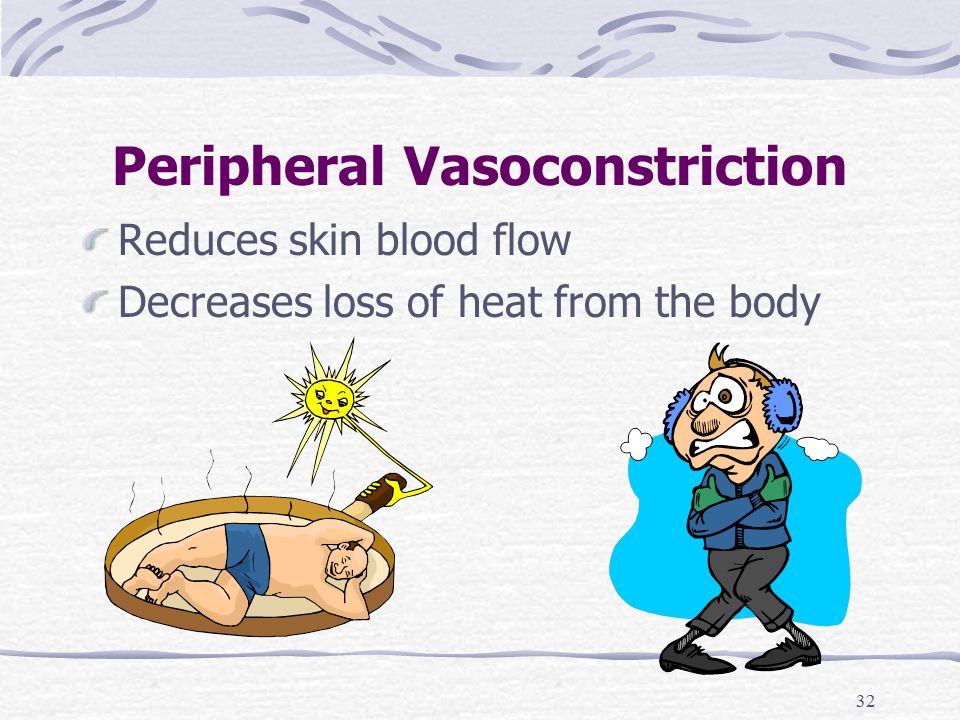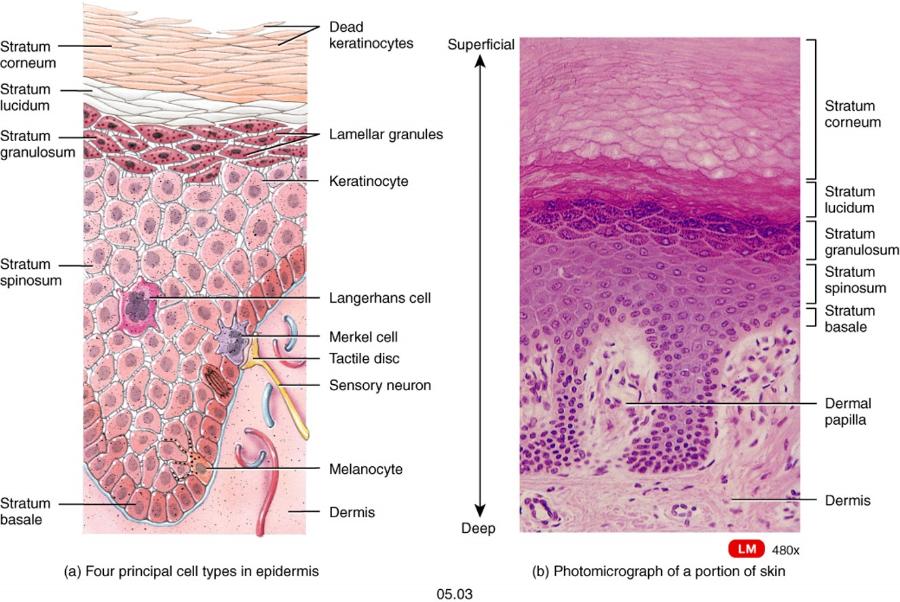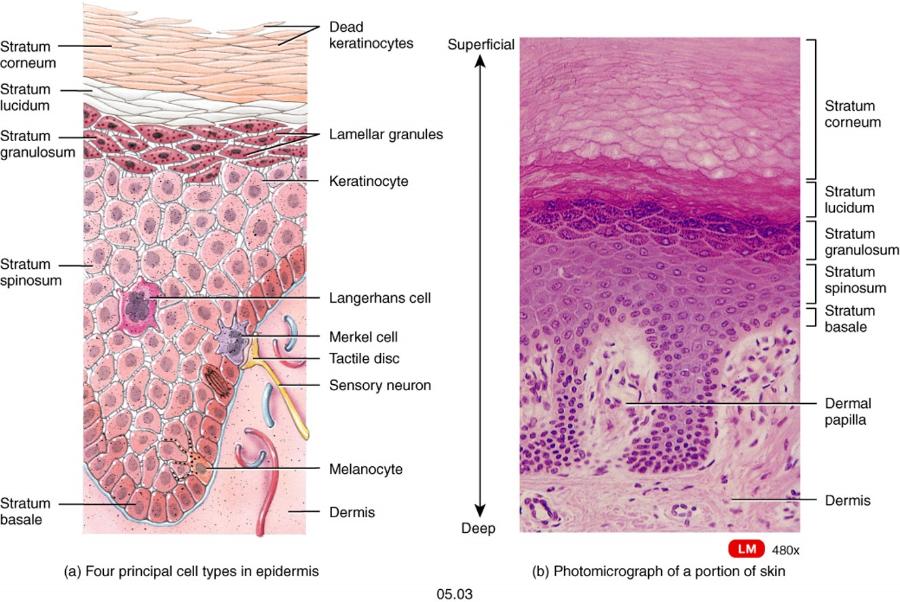The most abundant cells in the epidermis are
Answers:
a. keratinocytes.
b. melanocytes.
c. Merkel cells.
d.adipocytes.
e.Langerhans cells.
a. keratinocytes.
Which of the following statements is false concerning the outermost layer of the epidermis?
Answers:
a. Its cells are undergoing rapid cell division.
b. It is the first to experience any abrasion.
c. Keratin provides waterproofing.
d.Millions of cells are worn off daily.
e.It is called the stratum corneum.
a. Its cells are undergoing rapid cell division.
It is possible to obtain DNA from the nuclei of the cells of the stratum corneum.
Answers:
a. True
b. False
Selected Answer:
b. False
The layer of the epidermis that contains cells undergoing division is the
Answers:
a. stratum germinativum or basale.
b. stratum granulosum.
c. stratum lucidum.
d. stratum spinosum.
e. stratum corneum.
a. stratum germinativum or basale.
Which of the following is NOT found in the epidermis?
Answers:
a. stratified epithelium
b. tight cell junctions
c. blood vessels
d. keratin
e. melanin
c. blood vessels
The layer of the epidermis that contains melanocytes is the
Answers:
a. stratum spinosum.
b. stratum granulosum.
c. stratum germinativum or basale.
d. stratum lucidum.
e. stratum corneum.
Selected Answer:
c. stratum germinativum or basale.
The two components of the cutaneous membrane are the
Answers:
a. epidermis and superficial fascia.
b. epidermis and hypodermis.
c. integument and dermis.
d. epidermis and dermis.
e. dermis and hypodermis.
d. epidermis and dermis.
Variations in hair color reflect differences in the pigment produced by
Answers:
a. keratinocytes.
b. carotene cells.
c. melanocytes.
d. dermal papillae.
e. soft keratin.
c. melanocytes.
If the papilla of a hair follicle is destroyed,
Answers:
a. hair production will not be affected.
b. the follicle will not produce a hair.
c. the hair produced by the follicle will change from terminal to vellus.
d. the texture of the hair will become coarser.
e. the color of the hair will become lighter.
b. the follicle will not produce a hair.
Newly forming connective tissue in a wound is called
Answers:
a. granulation tissue
b. a scab
c. scar tissue
d. keloid
Selected Answer:
a.
granulation tissue
The scab that forms after an injury involving the dermis and epidermis consists mainly of
Answers:
a. collagen and trapped white blood cells
b. fibrin and trapped white blood cells
c. fibroblasts that produce fibrin, fibrin and platelets
d. collagen and trapped red and white blood cells
e. fibrin and trapped red blood cells
e. fibrin and trapped red blood cells
When scar tissue forms in the skin it means that
Answers:
a. there are more collagen strands in the dermis and fewer capillaries along with a lack of normal dermal structures.
b. there is a lack of blood vessels and a lack of the tough fibrous elements of the dermis such as collagen.
c. in the derms fibrin strands are regenerating quickly before epithelial cells have a chance to regrow
d. more blood vessels have invaded the area and caused a discoloration along with an excess of collagen fibers.
a. there are more collagen strands in the dermis and fewer capillaries along with a lack of normal dermal structures.
Scar tissue is the result of
Answers:
a. a lack of hair follicles and sebaceous glands in the injured area.
b. an abnormally large number of collagen fibers and relatively few blood vessels at the repair site.
c. a thickened stratum germinativum in the area of the injury.
d. increased numbers of fibroblasts and mast cells in the injured area.
e. increased numbers of epidermal layers in the area of the injury.
b. an abnormally large number of collagen fibers and relatively few blood vessels at the repair site.
Vitamin D is required for __________ metabolism.
Answers:
1. potassium
2. sulfur
3. zinc
4. phosphorus
5. calcium
Selected Answer:
5. calcium
The pale, crescent-shaped area at the base of a nail is called the
Answers:
a. lunula.
b. hyponychium.
c. cuticle.
d. eponychium.
e. cerumen.
a. lunula.
When the arrector pili muscles contract,
Answers:
a. the skin changes color.
b. shivering occurs.
c. "goose bumps" are formed.
d. hairs are shed.
e. sweat is released from sweat glands.
Selected Answer:
c. "goose bumps" are formed.
Hair is made up mostly of
Answers:
1. carbohydrates.
2. fats.
3. chitin.
4. calcium
5. keratinized cells.
5. keratinized cells.
When a fair-skinned person blushes, why does his or her skin turn red?
Answers:
a. The blood supply to the skin decreases.
b. The number of red melanocytes in the skin increases.
c. Increased heat causes the skin to turn red.
d. The blood supply to the skin increases.
e. Melanocytes increase production of red pigments.
d. The blood supply to the skin increases.
Eating large quantities of carrots and squash often changes the pigmentation of the skin. This pigmentation is visible because the increased consumption of these orange vegetables
Answers:
a. causes cyanotic coloration of the epidermis
b. can cause carotene to build up in the epidermis of the skin
c. can cause carotene to build up in the dermis and subcutaneous layers of the skin
d. can cause toxicity and lead to liver failure
b. can cause carotene to build up in the epidermis of the skin
An epidermal layer found only in the skin of the palms of the hands and the soles of the feet is the
Answers:
a. stratum lucidum.
b. stratum spinosum.
c. stratum granulosum.
d. stratum germinativum.
e. stratum corneum.
a. stratum lucidum.
The layer of the skin that provides protection against bacteria as well as chemical and mechanical injuries is the
Answers:
a. epidermis.
b. sebum layer.
c. subcutaneous layer.
d. stratum basale.
e. dermis.
a. epidermis.
Large quantities of keratohyalin would be found in the epidermal layer called the
Answers:
a. stratum lucidum.
b. stratum corneum.
c. stratum granulosum.
d. stratum germinativum.
e. stratum spinosum.
c. stratum granulosum.
Fine peach fuzz that replaces lanugo of fetal development prior to birth is called
Answers:
a. club hair
b. terminal hairs
c. cortex hair
d. vellus hairs
d. vellus hairs
Which statement below is true regarding hair associated with the scalp?
Answers:
a. Human are generally born with the number of hairs that they will have for life. They generally lose hair only when there is a serious medical condition.
b. Healthy adults shed over 200 hairs per day and may shed more during pregnancy or during stress.
c. Healthy adults shed between 50 to 100 hairs per day normally, although they may lose more after pregnancy and during periods of high stress.
d. Healthy adults rarely shed many hairs per day except after pregnancy and during periods of high stress.
c. Healthy adults shed between 50 to 100 hairs per day normally, although they may lose more after pregnancy and during periods of high stress.
Scar tissue is the result of
Answers:
a. a thickened stratum germinativum in the area of the injury.
b. an abnormally large number of collagen fibers and relatively few blood vessels at the repair site.
c. a lack of hair follicles and sebaceous glands in the injured area.
d. increased numbers of epidermal layers in the area of the injury.
e. increased numbers of fibroblasts and mast cells in the injured area.
b. an abnormally large number of collagen fibers and relatively few blood vessels at the repair site.
Stretch marks occur when
Answers:
a. athletes overextend a muscle.
b. the skin is so extensively stretched that its elastic capabilities are exceeded.
c. the hair follicles cease to produce hairs.
d. surgical incisions are made perpendicular to the skin's lines of cleavage.
e. the skin is stretched in normal movements.
b. the skin is so extensively stretched that its elastic capabilities are exceeded.
Nail production occurs at the nail
Answers:
a. body.
b. hyponychium.
c. bed.
d. root.
e. cuticle.
d. root.
An albino individual lacks the ability to produce
Answers:
a. eleidin.
b. keratin.
c. melanin.
d. perspiration.
e. carotene.
c. melanin.
The primary function of sensible perspiration is to
Answers:
a. protect the skin from excess ultraviolet radiation.
b. reduce insensible perspiration.
c. heat the skin surface.
d. cool the surface of the skin.
e. raise the temperature of the skin.
d. cool the surface of the skin.
The layer of the skin that contains bundles of collagen fibers and the protein elastin and is responsible for the strength of the skin is the ________ layer.
Answers:
a. hypodermal
b. papillary
c. subcutaneous
d. epidermal
e. reticular
e. reticular
The reticular layer of the dermis is composed of
Answers:
a. stratified squamous epithelium
b. adipose
c. dense regular fibrous CT
d. areolar CT
e. dense irregular fibrous CT
e. dense irregular fibrous CT
Glands that discharge an oily secretion into hair follicles are ________ glands.
Answers:
a. mammary
b. ceruminous
c. merocrine sweat
d. apocrine sweat
e. sebaceous
e. sebaceous
Charlie is badly burned in an accident. When he reaches the emergency room, the examining physician finds that he can remove entire hair follicles from Charlie's arm when he gently pulls on a hair with his forceps. After examining Charlie, the physician would likely order all of the following, except
Answers:
a. IV (intravenous) fluids and electrolytes.
b. a high-nutrient diet.
c. tissue samples for possible skin grafts.
d. ice packs adjacent to the burn area.
e. antibiotics.
d. ice packs adjacent to the burn area.
Cyanosis is indicated by
Answers:
a. an orange skin coloration.
b. a yellowish skin coloration.
c. a brown skin coloration.
d. a reddish skin coloration.
e. a bluish skin coloration.
e. a bluish skin coloration.
Where is Epidermal Growth Factor (EGF) Produced?
In the Salivary and duodenum glands
Where in the body would EGF be utilized?
- Anywhere there is skin damage
- Sunburns
- TSP (Trisodium Phosphate)- whitening agent used in toothpaste destroys skin in mouth
- Chemo causes mouth sores
What are the functions of EGF?
- Promotes division of germinative cells
- Accelerates keratin production
- stimulates epidermal repair - wound healing
- stimulates glandular secretion
What is Epidermal Growth Factor (EGF)?
- replaces cells in the epidermis
- powerful peptide growth factor
- used in labs to grow skin grafts
Deodorants are used to mask the odor of ________ secretions.
Answers:
a. sebaceous
b. mammary
c. apocrine
d. merocrine
e. ceruminous
c. apocrine

Peripheral vasoconstriction is a response to
Answers:
1. hunger.
2. exercise.
3. cold.
4. thirst.
5. heat.
3. cold.

Vasodilation is a response to
Answers:
a. heat
b. cold
c. freezing temperatures
a. heat
What condition is caused by Vitamin D3 deficiency?
Rickets Disease or genetic bone defects.
What is Vitamin D3?
- Cholecalciferol
- Epidermal cells produce it
- Liver and Kidneys convert it into Calcitriol (an aid to absorb calcium and phosphorus)
What are the functions of Skin (Epidermis and Dermis)?
- Protects underlying tissues and organs through production of keratin
- Excretes salts, water, and organic wastes (glands)
- Maintains body temperature (insulation and evaporation)
- Synthesis of melanin
- Synthesizes vitamin D3
- Stores lipids
- Detects touch, pressure, pain, and temperature
What are the functions of the Epidermis?
- Protects the Dermis
- prevents water loss & pathogens from entering
- Synthesis of Vitamin D3 (aka Cholecalciferol)
- Sensory Receptors:
- detect touch
- pressure
- pain
- temperature
What are the two layers of the Dermis?
- Papillary layer
- Reticular Layer
What is the function of the Papillary layer?
- Nourishes & Supports the Epidermis
What is the function of the Reticular Layer?
- has sensory receptors which detect:
- touch
- pressure
- pain
- vibrations
- temperature
- Has Blood Vessels - assist in
thermoregulation
- vasoconstriction - when exposed to cold
- vasodilation - when exposed to heat
What cells are most abundant in the Epidermis?
Keratinocytes

Name the layers found in Thin Skin
- AKA 4 Layers of Strata of Keritinocytes
- only in the Epidermis
- Stratum Corneum (thin outermost layer in thin skin - aka Free Surface)
- Stratum Granulosum
- Stratum Spinosum
- Stratum Basale

Name the layers found in Thick Skin
- AKA 5 Layers of Strata of Keritinocytes
- only in the Epidermis
- Stratum Corneum (thick outermost layer in thick skin - aka Free surface)
- Stratum Lucidum
- Stratum Granulosum
- Stratum Spinosum
- Stratum Basale
- and then the Basement layer which separates Epidermis from Dermis
What attaches the Stratum Basale to the Dermis?
Hemidesmosomes
- forms a strong bond between Epi and Dermis
What layer of the Epidermis forms Ridges (fingerprints and Dermal papillae (tiny mounds)
Stratum Basale
What two cells are found in the Stratum Germinativum in thick skin?
- Merkel cells
- in hairless skin (respond to touch)
- Melanocytes
- contain melanin
- scattered throughout the Stratum Germinativum
Facts to know about Stratum Spinosum (spiny layer)
- Produced by division of stratum basale
- Eight to ten layers of keratinocytes bound by desmosomes
- Cells shrink until cytoskeletons stick out (spiny)
- Continue to divide, increasing thickness of epithelium
- Contain dendritic (Langerhans) cells, active in immune response
Facts to know about Stratum Granulosum (grainy layer)
- The “grainy layer”
- Stops dividing, starts producing
- Keratin:
- a tough, fibrous protein
- makes up hair and nails
- Keratohyalin :
- dense granules
- cross-link keratin fibers
What are the functions of Stratum Granulosum?
- Produce protein fibers
- Dehydrate and die
- Create tightly interlocked layer of keratin surrounded by keratohyalin
What layer is only found in Thick Skin?
- Stratum Lucidum — the “clear layer”
- Found only in thick skin
- Covers stratum granulosum
- Found between Granulosum and Corneum
- It's the dark pink layer above the purple layer (granulosum on the slide)
Facts to know about Stratum Cornium
- the “horn layer”
- Exposed surface of skin
- 15 to 30 layers of keratinized cells
- Water resistant
- Shed and replaced every 2 weeks
In what layer of skin does Keratinization take place?
Stratum Corneum
What is Keratinization?
- The formation of a layer of dead, protective cells filled with keratin
How many days does it take for cells to Keratinize?
- Skin life cycle
- It takes 15–30 days for a cell to move from stratum basale to stratum corneum
Name the two types of Persperation
- Sensible
- Insensible
Which type of Perspiration causes water to excrete by sweat glands causing possible dehydration?
Insensible Perspiration
Which type of Perspiration is caused from damage to the stratum corneum (via blisters or burns)
Insensible Perspiration
Which type of Perspiration is caused from immersion in hypertonic solution (e.g., seawater [osmosis])
Insensible Perspiration
What two pigments influence skin color?
Carotene and Melanin
Where is Carotene Found in the skin?
accumulates in epidermal cells and fatty tissues of the dermis
What produces Melanin and what layer of epidermis is it found in?
- produced by melanocytes in stratum basale
- stored in transport vesicles (melanosomes)
- transferred to keratinocytes
Info on Dermal Blood Supply
- The Dermal Blood Supply
- Cutaneous plexus
- A network of arteries along the reticular layer
- Papillary plexus
- Capillary network from small arteries in papillary layer
- Venous plexus
- Capillary return deep to the papillary plexus
- Contusion
- Damage to blood vessels resulting in “black–and–blue” bruising
Facts on Dermis
- Innervation of the Skin
- Nerve fibers in skin control:
- Blood flow
- Gland secretions
- Sensory receptors
- Light touch—tactile corpuscles, located in dermal papillae
- Deep pressure and vibration—lamellated corpuscles, in the reticular layer
Facts on Hypodermis
- The subcutaneous layer or hypodermis
- Lies below the integument
- Stabilizes the skin
- Allows separate movement
- Is made of elastic areolar and adipose tissues
- Is connected to the reticular layer of integument by connective tissue fibers
- Has few capillaries and no vital organs
- Is the site of subcutaneous injections using hypodermic needles
Hair Follicle ino
- Is located deep in dermis
- Produces nonliving hairs
- Is wrapped in a dense connective tissue sheath
- Base is surrounded by sensory nerves (root hair plexus)
Arrector Pilli info
- Involuntary smooth muscle
- Causes hairs to stand up
- Produces “goose bumps”
Sebaceous Glands
- Lubricate the hair w oily substance
- Control bacteria
Hair root
- Lower part of the hair
- Attached to the integument
Hair Shaft
- Upper part of the hair - what we see
- Not attached to the integument